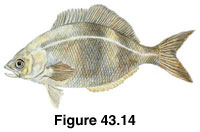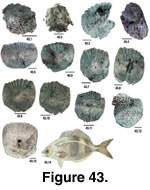 Description
Description
Cymatogaster aggregata
(Shiner Perch)
(Other common names: Shiner, Yellow Shiner, Gaadaa, Shiner Seaperch, Shiner Surfperch)
Figure 43.14
 Description
DescriptionLength: to approximately 20 cm.
Mouth: small, slightly pointed upward, terminal; upper jaw four-fifths length of the snout; lower lip free from lower jaw (no frenum); teeth are fine.
Body: head slightly concave in profile at eye; lateral line parallels dorsal body contour; caudal peduncle is compressed and slender.
Color: silvery with rows of dark spots that form stripes; these strips are crossed by three yellow bars (males only in winter); sometimes with dark spot above lip.
Depth: to 130 m; common in shallows but found deeper during the winter.
Habitat: common in bays, eel grass beds, and pilings in protected areas; euryhaline.
Season: mate year round; females gravid spring through summer and give birth from May through August; estuaries used as nursery grounds; females immigrate from nearshore coastal waters prior to giving birth. Maturing males migrate to the ocean, while most females spend their first year in nearshore bays.
Diet: zooplankton, crustaceans, polychaetes, molluscs, algae, and detritus.
Predators: sturgeon, sea bass, salmon, sharks, Cottidae, Scombridae, sea birds (cormorants); marine mammals (harbour seals; Iverson, 1962; Oliphant, 1962; Talent, 1976; Armstrong et al., 1995).
Distribution: Baja, California to southern Alaska.
 Scale Description
Scale DescriptionRelative Scale Size: moderate to large.
Position of Scales on Body: on lateral line canal, and the anterior three-quarters of the dorsal fin marked by the dorsal furrow (Hart, 1973).
Overall Shape: the posterior field is rounded, but the anterior field is round to square (more so in the larger scales giving the appearance of a rounded rectangle).
Focus and Circuli: the focus is centralized between the four fields and the circuli extending from the focus are somewhat pyriform-shaped in the direction of the lateral fields (giving it an elongated appearance). The circuli are generally continuous in all fields (except where broken by radii).
Radii: numbers are variable and not diagnostic. Present only in the anterior field. The outer edge of the anterior field is scalloped.